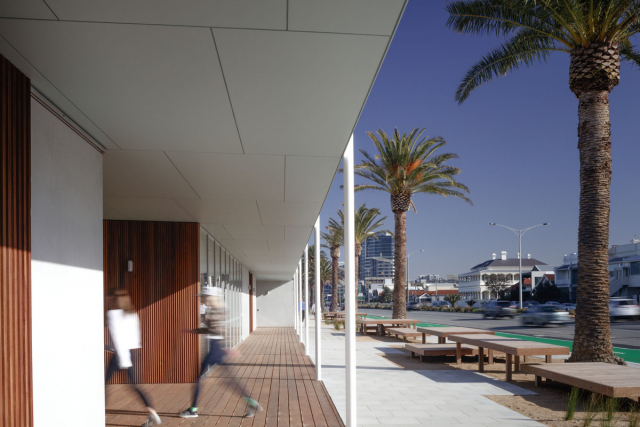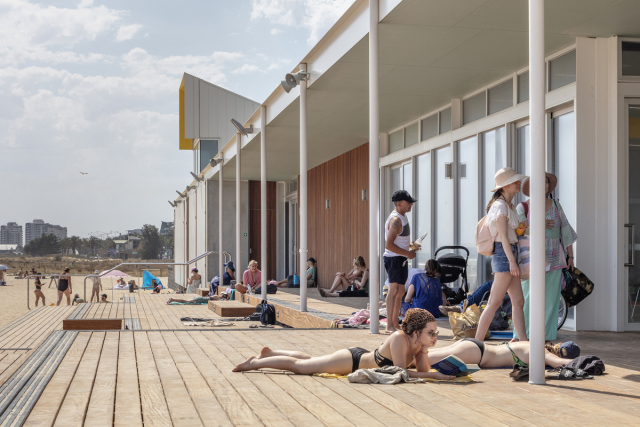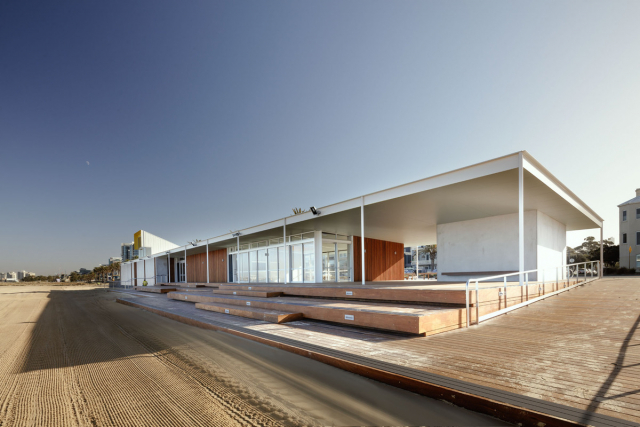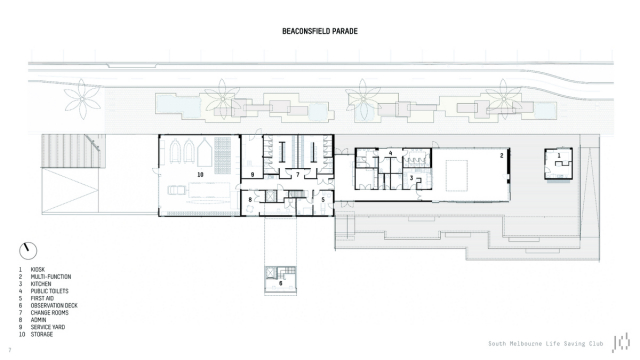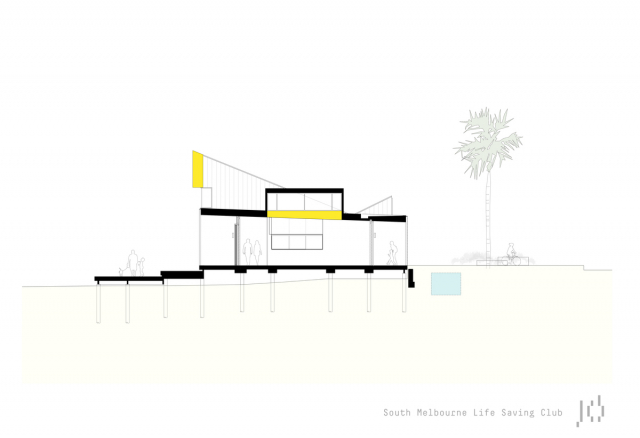Designed by Jackson Clements Burrows Architects (JCB), the new South Melbourne Life Saving Club responds to the linear nature of the foreshore that stretches from St Kilda to Port Melbourne.
Both Beaconsfield Parade and the beach promenade are primarily concerned with pedestrian, cycling and vehicular movement, which prompted the built form to capture and celebrate this dynamic flow and the horizon line beyond.
Accentuating the linear, horizontal qualities of the site resulted in a low-profile roofline that minimise disruption to local residents’ views and makes it a sensitive addition to the neighbourhood.
The siting of the previous building restricted the public foreshore path, which resulted in conflicts between bikes and pedestrians.
This was addressed by perching the building on the edge of the bluestone sea wall, which reinstated the full width forecourt to allow separate pedestrian and cycle paths, as well as additional seating and landscaping opportunities.
This new configuration provides a liberated thoroughfare, where pedestrians and cyclists can both move together easily and safely.
As a public building, JCB wanted it to feel open and accessible to the community.
A highly transparent multi-purpose space is surrounded by an expansive under-cover deck; these elements encourage views to the bay and offer an opportunity to pause and engage with the beach, the club and the community functions happening within.
Appreciating the location as a popular recreational destination, the generous terraced deck invites visitors from the verandah down to the beach, providing the club and public ample opportunities to inhabit and enjoy the beachside environment.
Triangular pop-up roof lights of varying sizes maximise internal volume and daylight, while providing a dual role of concealing roof services and equipment.
The largest of these roof lights serves as the club’s observation room overlooking the beach.
The roof lights also provide a playful addition by referencing boating activity and sails on the bay.
Internally the pop-ups are coloured red, yellow and pink, like faded beach towels and sunburn.
These colours evoke happy memories of bygone summers, not least of swimming between the safety beach flags.
The project achieves a Five Star Green Star accreditation and integrates several passive and active measures to achieve multiple sustainable outcomes.
The low roof line creates deep shaded eaves to keep direct sunlight off the glass for much of the day.
Cross flow ventilation is achieved via the long narrow plan and vented louvered windows in the pop-up skylights.
Beyond this, further sustainable initiatives by JCB were implemented including a 36 kilowatt solar photo voltaic system designed to offset all greenhouse emissions on an annual basis.
Best practice for urban storm water quality was also applied, with the use of 48,000 litres of tank storage.
Live electronic display screens calculate and display the building’s overall water and energy savings achieved by the PV solar array and stormwater systems.
Project Details
Project Size – 1,625 m2
Project Budget – $6,800,000
Completion Date – 2019
Building Levels – 1
Project Team
Architecture
Jackson Clements Burrows Architects (JCB)
Established in 1998 by Tim Jackson, Jon Clements and Graham Burrows, JCB is a design-led architectural practice of over 50 design professionals united by a shared commitment to the delivery of innovative design solutions.
Photography
John Gollings
John has been the photographer of choice, the go-to guy for many Australian architects.
He is renowned for his ability to almost always compose the best shot, the one defining image that makes a building memorable, etches it into the psyche.
Photo Gallery
Click on a thumbnail image to enlarge.
Design © 2021 Jackson Clements Burrows Architects (JCB). All Rights Reserved.| Images © 2021 John Gollings. All Rights Reserved.
Get the Builtworks Letter
In every edition of the Builtworks Letter, you’ll get the behind-the-scenes backstory as to how buildings, structures, and places are designed, built, and brought to life.
You’ll hear compelling stories, learn surprising ideas, meet engaging characters, and discover unique voices.





